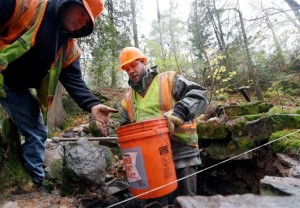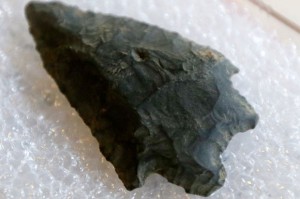Archaeologists uncovered ten thousand year old Native American artifacts in Lake George, proving that the area was one of the earliest occupied sites in New York. Some of these artifacts included projectile arrowheads from the French and Indian War and sharp edged rocks, which were possibly used to skin animals or chop up raw materials. The archaeologists were sent out to find artifacts from the French and Indian War and eventually they found artifacts dating much earlier than that time period. The team of archaeologists did this by first mapping out their excavation site. Instead of conducting the excavation right on Lake George’s present shoreline, the team of archaeologists began digging a few hundred feet from the beach. The archaeologists chose this site because it was estimated that in prehistoric times, this area would have been the shoreline. Interestingly enough, some of the artifacts found did not initially originate in the Adirondack region. From this observation archaeologist Christina Rieth observed that these people who left these artifacts behind were hunters and gatherers who spent time in what was once an area of wetlands. Rieth said, “It would be kind of a transit group, people who would have come here year after year for fishing or other types of activities around the lake.” She believes that these artifacts came from outside the region or were traded for other tools. According to her one of the stone pieces came from an eastern part of Pennsylvania and some of the others could have come from Central New York.
John Hart, the State Museum director of research and collections, also mentioned that these artifacts aren’t from a permanent settlement. He believes that these artifacts came from a band of nomads who were in search for migrating birds, deer, and other raw materials. Both Hart and Rieth said the artifacts appear to be from an era much earlier than that of famous Native American tribes. The incredible aspect about these finds was that archaeologists were assigned to do a routine inspection as a part of the states’ plans to resurface the roads near Lake George. So there was a bit of luck for the archaeologist to find these findings since they had no systematic plan of what to look for specifically. The only things these archaeologists were expected to find were artifacts from the French and Indian war. The main point that did help was that they were digging at a spot, which was once the shoreline for Lake George. In all, the dig became a lucky success even though there was no initial plan and project to specifically find certain artifacts from a single time period.

Two archaeologists are in the process of collecting soil and dirt in a bucket and then through sifting locating the artifacts.
Photo 2: http://4.bp.blogspot.com/-DvZKRk3S5ZU/UnP_Gn7I-II/AAAAAAAA27c/lxGsxFRoIdU/s1600/USA_NY_01.jpg
References: http://www.timesunion.com/local/article/Digging-10-000-years-into-the-past-4944785.php
http://wnyt.com/article/stories/s3205728.shtml?cat=300
Renfrew, Colin, and Paul G. Bahn. Archaeology Essentials: Theories, Methods, and Practice. New York, NY: Thames & Hudson, 2010. Print.
Additional readings:
http://www.cnycentral.com/news/story.aspx?id=1041983
http://www.timesunion.com/local/article/Lake-George-dig-site-teaches-students-of-5467292.php


As you state in your title, luck can play a large role in the practice of archaeology. This incredible find at Lake George emerged from a routine inspection where the archaeologists “had no systematic plan of what to look for specifically.” Artifacts are present virtually everywhere, including under the asphalt of a parking lot or in someone’s backyard. In fact, people often happen upon valuable artifacts simply by chance. When this occurs, it’s important that they follow the proper protocol or else potential knowledge about the object and the society from which it originates may be lost. Since much of archaeology relies upon contextual information, the location of the object is of paramount importance. Relationships between different artifacts at the same site are similarly significant. Therefore, when bringing an artifact into authorities, people should document both the appearance of and where they found the artifact before moving it.
To find out more on the protocol for finding an artifact, check out the following link:
http://www.winonadailynews.com/news/local/find-an-artifact-here-s-what-to-do-with-it/article_580827cc-0fa1-11e0-8493-001cc4c002e0.html
The title is a little deceiving but the only reason why I said and still believe these were lucky finds is because the archaeologists weren’t expecting to find artifacts from 10,000 years ago. Rather, “The only things these archaeologists were expected to find were artifacts from the French and Indian war” (Wagman). The archaeologists had some idea of what they were looking for (artifacts from the French and Indian War) but they weren’t a hundred percent sure. The team of archaeologists did have some kind of a plan before setting out to the dig but once they found these very old artifacts their excavation plan became skewed. But to make it clear, it wasn’t lucky that these archaeologists found artifacts since artifacts are found everywhere like you said. It’s the fact these artifacts found were so old and were dated before the French and Indian war. Thank you for commenting on my post and I will be sure to check out the link provided.
Cultural Resource Management projects like this one form the bulk of archaeology being done in this country. Sometimes little is found and the project can continue as planned. Other times an unexpected discovery like this one helps us to rewrite the history of a region.